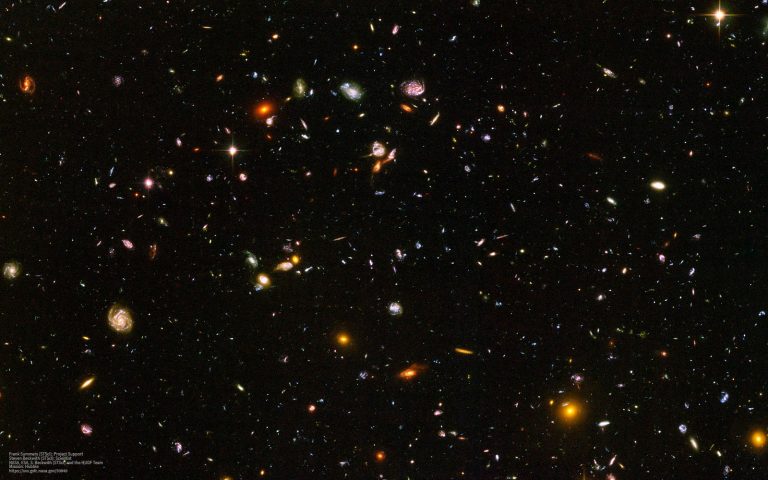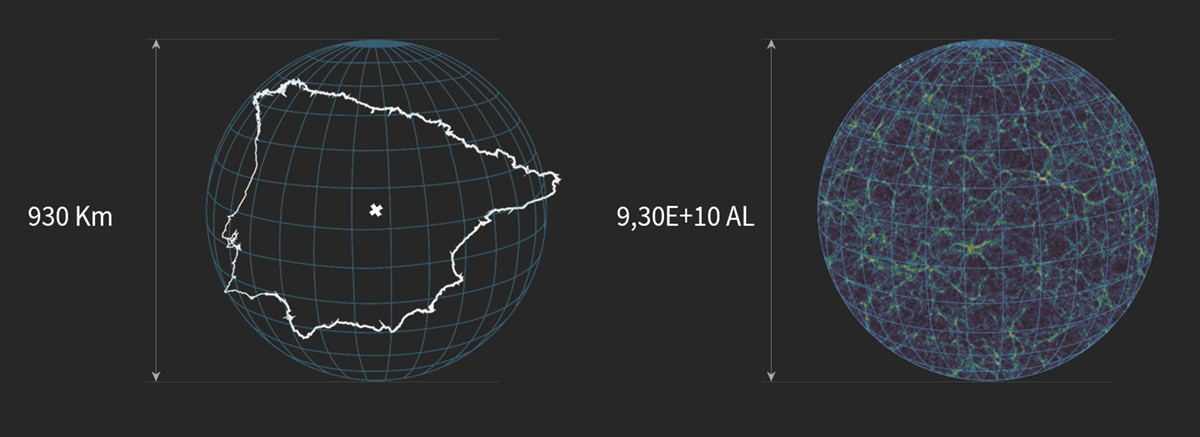
Iberian universe
25 June, 2021On the summer´s nights that has just begun, under the stars it is easy to feel tiny before the immensity of the Universe. We look up and imagine what is happening near that star or that other one. We wonder if there is perhaps someone there in the distance, at this moment, looking up at the sky thinking the same thing.
It could be an impossible task to try to digest the enormous size of the universe, and we are only talking about the observable universe, which, perhaps, is only a small part of the total. But that's what scales are for, the wonderful art of scale. I remember a Radio 3 show called “El Mono Temático“, I loved it; They talked about science and then they put on a topic of The Who, Led Zeppelin or Pink Floyd, without more nonsense. I remember that in some program they made a comparison of enormous spatial distances with mundane objects: something like if our sun were an orange, the closest star would be another orange located 2997 kilometers (1862 miles).
This was an ideal way to assimilate sizes and distances. almost 6 years ago, Wylie Overstreet y Alex Goros they did a wonder called “The solar system to scale” which is, in images, what they did, in radio format, on the Angel Rodríguez Lozano 20 years ago....
So, the best thing to do a transformation from sizes to scales is to do it with something you know. Let us compare, then, the universe with the Iberian Peninsula.
To make an easy scale comparison between the observable universe and the Iberian Peninsula, let's imagine that we establish an imaginary circle with a radius of 465 km (that is, a diameter of 930 km) and with a center of Madrid.
In this way, we will have an easy-to-manage correlation, that is:
93.000 millions years / 930 km = 100 millions.
That is, each kilometer of the Iberian Peninsula is equivalent to 100 million light years in the observable universe.

1 Km (That is, 1000 meters) is 100 million light years in the real universe, so each meter will represent 100.000 light years. Considering that this is the diameter (approximate) of our Milky Way, we can start to digest the size.
The objective is for our head to try to establish a comparison... For anyone who has seen an endless carpet dotted with fields, roads and lakes through the window of the plane during an approach maneuver to Barajas Airport, or who has traveled the highways of infinite horizons of La Mancha or through the deep valleys and high peaks of the Cantabrian mountain range, You can take a look at the distant horizon and compare it with an object you have on hand that measures 1 meter in diameter (the fabric of an open umbrella, for example) and think about what that umbrella would look like at that distance or even further away. . points? Maybe something even smaller than a point? Those points are the billions of “umbrellas” (galaxies) spread throughout the territory of Spain (observable universe)
The closest supernova to Earth in recent decades is the M82 galaxy, located about 12 million light years from Earth. In our scale comparison, in our “Iberian universe”, this magnificent explosion It would be located at the end of the street, about 120 meters from our umbrella (The Milky Way). In this comparison, the sun and the planets of our solar system would be at a microscopic interval from our retina and the closest stars Alpha and Proxima Centauri would be a few microscopic intervals further, also close to us.
To visualize the distance to our neighboring galaxy, Andromeda, Let's imagine that we are at a bus stop where 2 city buses are stopped picking up passengers, one next to the other. Placing our 1 meter umbrella (The Milky Way) on the front door of the first vehicle, Andromeda would be a bar umbrella of about 2 meters in diameter located one or two steps beyond the end of the second bus, about 25 meters. The Large Magellanic Cloud, It would be like a CD that we dropped and rolled 1.5 meters away from us. The small Magellanic Cloud, It would be like a mini CD located about 70 cm from the latter, almost 2 meters from where we are.
(I am open to the idea that, if the comparative calculations are not well done, you can let me know without any problem!)
Credits:
header image:
Frank Summers (STScI): Project Support
Steven Beckwith (STScI): Scientist
NASA, ESA, S. Beckwith (STScI) and the HUDF Team
Mission: Hubble
https://svs.gsfc.nasa.gov/30946
imagen comparativa: DGB
Pd.: Fortunately, we can continue enjoying the good work of Ángel Rodríguez Lozano in Cienciaes.com
In addition, there are other popularizers of science and, above all, everything related to space and the universe such as José Manuel Nieves, that you should not stop seeing/listening to. I am a faithful follower of Materia Oscura as well as the Youtube channel of this brilliant scientist, or as Carlos Briones, author of the book that I am now savoring: “Are we alone? (¿Estamos solos?)“. Well, this is dedicated to the three of them, who are largely responsible for writing this post.





